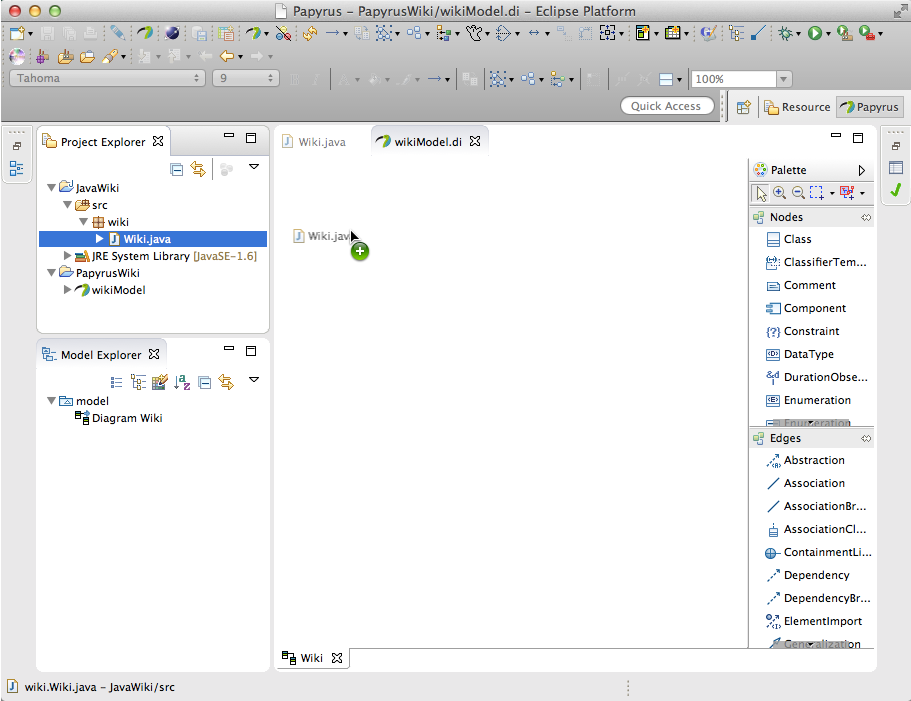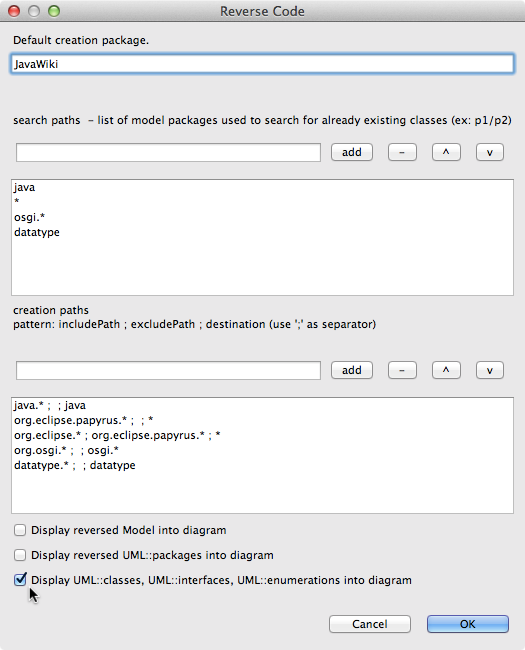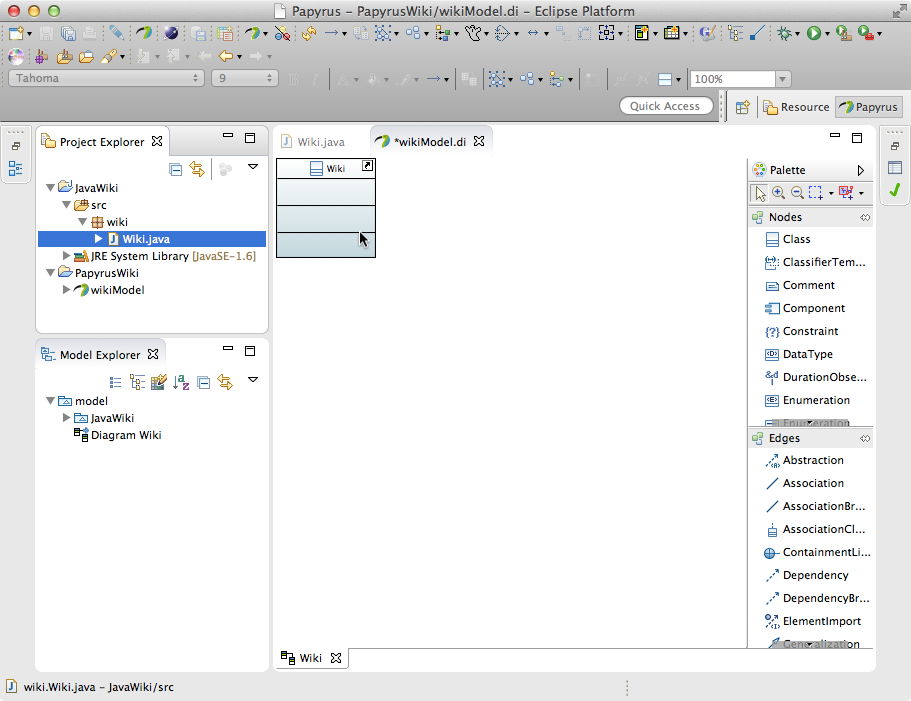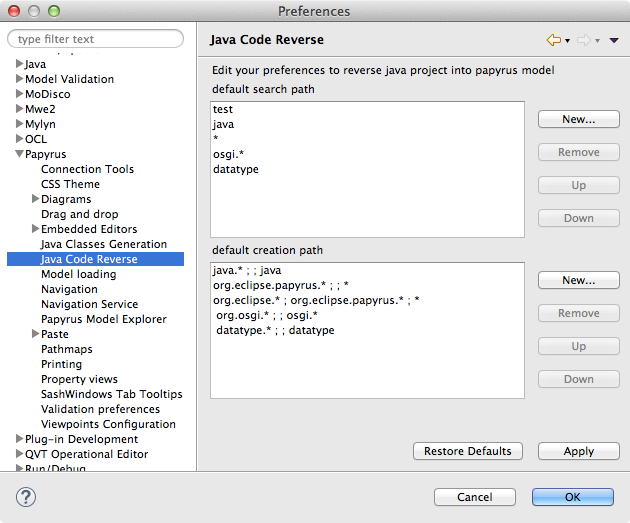Notice: This Wiki is now read only and edits are no longer possible. Please see: https://gitlab.eclipse.org/eclipsefdn/helpdesk/-/wikis/Wiki-shutdown-plan for the plan.
Difference between revisions of "Java reverse engineering"
m (Capitalization, spelling, and grammar edits only.) |
m (Minor grammar edits.) |
||
| Line 1: | Line 1: | ||
| − | + | Java Reverse Engineering is available in the extra plugins of Papyrus. It allows Java files or packages to be reverse-engineered into a Papyrus class diagram. | |
== Installation Instructions== | == Installation Instructions== | ||
| Line 21: | Line 21: | ||
* click the Reverse button [[File:ReverseButton.jpg]] | * click the Reverse button [[File:ReverseButton.jpg]] | ||
| − | A UML class | + | A UML class is created in Model Explorer. You can now add it into your diagram. |
Note that all associated classes have also been added to the model. | Note that all associated classes have also been added to the model. | ||
| Line 34: | Line 34: | ||
==== Reverse-engineering settings ==== | ==== Reverse-engineering settings ==== | ||
| − | By default, a package named "generated" is created for reverse-engineering. You can choose another package name on the options menu. | + | By default, a package named "generated" is created for reverse-engineering. You can choose another package name on the options menu. |
[[Image:JavaReverseOptionsMenu.jpg]] | [[Image:JavaReverseOptionsMenu.jpg]] | ||
| Line 44: | Line 44: | ||
=== Using Drag & Drop === | === Using Drag & Drop === | ||
| − | You can reverse-engineer a class or a package | + | You can reverse-engineer a class or a package by just dragging & dropping it on a Papyrus diagram: |
* Drag one or more classes and/or packages, | * Drag one or more classes and/or packages, | ||
| − | * Drop the selection | + | * Drop the selection into an open diagram. |
[[Image:JavaReverseDragAndDrop.png]] | [[Image:JavaReverseDragAndDrop.png]] | ||
| − | A settings dialog is opened. You can modify settings (please see Reverse settings). | + | A settings dialog is opened. You can modify settings (please see Reverse settings). |
| − | + | When you're reverse-engineering via the drag & drop method, you can also choose to display model, packages, and classes / interfaces / enumerations into the Papyrus diagram. To enable display, just click into the check-boxes: | |
[[Image:JavaReverseDnDPopUp.png]] | [[Image:JavaReverseDnDPopUp.png]] | ||
Revision as of 13:52, 13 August 2015
Java Reverse Engineering is available in the extra plugins of Papyrus. It allows Java files or packages to be reverse-engineered into a Papyrus class diagram.
Contents
Installation Instructions
Java Reverse Engineering is available as a Papyrus extra plugin.
You can install it by using the Papyrus update site corresponding to your Papyrus version:
Or you can use the nightly build update site (paste following URL in eclipse update site):
Then :
- Unselect 'Group item by category'
- Select ' Papyrus Java Reverse (Incubation)'
- Finish
How to use Reverse
Using Command
Reverse-engineer a Java class
A Java class can be reverse-engineered into a Papyrus class diagram:
A UML class is created in Model Explorer. You can now add it into your diagram. Note that all associated classes have also been added to the model.
Reverse-engineer a package
A Java package (and all classes included) can be reverse-engineered into a Papyrus class diagram:
Packages and classes have been created in Model Explorer. Your can now add them to your diagram. Note that all associated classes have also been added to the model.
Reverse-engineering settings
By default, a package named "generated" is created for reverse-engineering. You can choose another package name on the options menu.
This options menu allows to:
- change the default package of the reverse-engineering,
- add or remove search path. The reverse generator search existing UML classes and regenerate them.
- add or remove creation path. The reverse generator search on existing Java classes to generate a UML class. Useful for creating Java imports (e.g.: String, Integer).
Using Drag & Drop
You can reverse-engineer a class or a package by just dragging & dropping it on a Papyrus diagram:
- Drag one or more classes and/or packages,
- Drop the selection into an open diagram.
A settings dialog is opened. You can modify settings (please see Reverse settings). When you're reverse-engineering via the drag & drop method, you can also choose to display model, packages, and classes / interfaces / enumerations into the Papyrus diagram. To enable display, just click into the check-boxes:
When you click on the OK button, your components are displayed in the Papyrus diagram. Note: while all selected components are reversed-engineered, only components which are in selection, but not in the Papyrus diagram are displayed.
Change default reverse-engineering settings
The Java code reverse-engineering plugin allows you to change default settings on eclipse preferences:
- Open Eclipse Preferences,
- Search for the Papyrus section,
- Choose Java Code Reverse sub-section
In this preferences page, you can change:
- default search path values,
- default creation path values.
Note that there are default values; if you have changed these values for a project, your changes are saved, and default values are not used.





